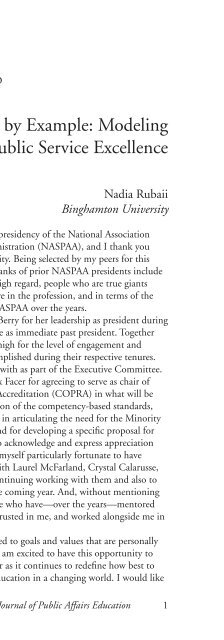WINTER 2012 - National Association of Schools of Public Affairs and ...
WINTER 2012 - National Association of Schools of Public Affairs and ...
WINTER 2012 - National Association of Schools of Public Affairs and ...
You also want an ePaper? Increase the reach of your titles
YUMPU automatically turns print PDFs into web optimized ePapers that Google loves.
Leading by Example: Modeling Global <strong>Public</strong> Service Excellence<br />
<strong>of</strong> opinion on how to proceed. These differences are underst<strong>and</strong>able <strong>and</strong><br />
appropriate, but they cannot become the basis for division because we also have<br />
common elements <strong>of</strong> our missions <strong>and</strong> some overlapping memberships.<br />
To the extent that we have a common interest in promoting public<br />
affairs education <strong>and</strong> enhancing the visibility <strong>and</strong> reputation <strong>of</strong> public service<br />
pr<strong>of</strong>essions, we need to be united. In the coming year, NASPAA needs to<br />
determine how to build, enhance, <strong>and</strong> exp<strong>and</strong>—or, if necessary, to restore<br />
or repair—its relationships with its sister associations <strong>and</strong> with schools <strong>and</strong><br />
programs that have disengaged with the <strong>Association</strong>. NASPAA must take the lead<br />
in forging these partnerships <strong>and</strong> collaborations grounded in what unites us all.<br />
THE WHOLE IS GREATER THAN THE SUM OF ITS PARTS.<br />
What we do as individual scholars to apply a theoretical <strong>and</strong> evidence-based<br />
lens to the issues <strong>of</strong> public management <strong>and</strong> public policy, <strong>and</strong> what we do as<br />
deans <strong>and</strong> directors to ensure that our programs are designed to provide a highquality<br />
educational experience to our students, <strong>and</strong> what we do as individual<br />
faculty in the classrooms to light the fires <strong>of</strong> public service passion <strong>and</strong> to prepare<br />
competent pr<strong>of</strong>essionals are all vital contributions to the quality <strong>of</strong> public<br />
service. But our true potential is not in our activities as individual scholars or<br />
administrators or teachers, but rather in our collective energies.<br />
We all know that history repeats itself, that economies are characterized by<br />
boom-<strong>and</strong>-bust cycles, <strong>and</strong> that periods <strong>of</strong> corruption <strong>and</strong> narrow self-interest<br />
are <strong>of</strong>ten followed by reform movements designed to restore public trust <strong>and</strong><br />
pr<strong>of</strong>essionalism. So, to the extent that we look around us <strong>and</strong> see lots <strong>of</strong> negative<br />
conditions <strong>and</strong> dysfunctional behavior, we can also see tremendous opportunities<br />
for improvement, but only if we act collectively. NASPAA has a responsibility to<br />
create the means by which we realize a whole that is greater than the sum <strong>of</strong> its parts.<br />
As part <strong>of</strong> a philosophy <strong>of</strong> “the whole is greater than the sum <strong>of</strong> its parts,”<br />
NASPAA can <strong>and</strong> should look for opportunities to use technology, as well as the<br />
<strong>Association</strong>’s convening capacity, to facilitate partnerships <strong>and</strong> collaborations that<br />
will allow individuals, programs, <strong>and</strong> associations to work together in creative<br />
ways to promote collective progress for the good <strong>of</strong> those we serve. The quality<br />
<strong>of</strong> services provided to people—whether they live in Washington, D.C., or<br />
Seoul, Korea; in Kansas City, Missouri, or Milan, Italy; in San Jose, California,<br />
or San Jose, Costa Rica—will be better if all programs that educate current <strong>and</strong><br />
future public administrators are held to high st<strong>and</strong>ards <strong>and</strong> if those programs are<br />
able to work together to prepare graduates to address complex social, political,<br />
<strong>and</strong> economic challenges <strong>of</strong> the 21st century. As a result, NASPAA has a<br />
responsibility to focus on the common values that unite public affairs programs<br />
<strong>and</strong> to actively pursue opportunities for collaboration to achieve goals that could<br />
not be fully attained by individual programs acting in isolation.<br />
These six principles—(1) Walk the Walk; (2) Diversity <strong>and</strong> Social Equity<br />
Matter; (3) Global Leadership <strong>and</strong> Partnership; (4) Our Work Doesn’t End at the<br />
Journal <strong>of</strong> <strong>Public</strong> <strong>Affairs</strong> Education 7

















